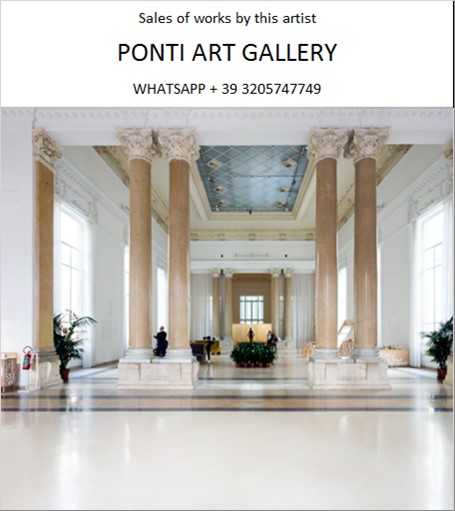Ponti Art Gallery is interested in buying and selling works
of art by this artist.

Vinicio Paladini Biography
Vinicio Paladini was an Italian architect, painter, and art theorist born in Moscow on June 21, 1902, to an Italian father and a Russian mother. His family moved to Rome in 1903, where he would spend much of his life and career. Paladini's work and ideologies were deeply influenced by the socio-political movements of his time, making him a significant figure in the Italian avant-garde movement between the World Wars.
In the early 1920s, despite his socialist and pro-Soviet leanings, Paladini joined the Futurist movement, aligning with Alexander Bogdanov's theories that viewed Futurism as an anti-bourgeois movement poised to usher in the revolution. He became a close friend and collaborator of Ivo Pannaggi, with whom he staged the "Futurist Mechanical Dance" in 1922 at Casa Arte Bragaglia. That same year, they co-authored the "Manifesto of Futurist Mechanical Art," advocating for the identification between the proletariat and the machine. This stance, however, led to a rift with Filippo Tommaso Marinetti, the leading figure of Futurism, especially after Marinetti's public embrace of Fascism, prompting Paladini to disavow the movement.
Following his departure from Futurism, Paladini initiated the Imaginist movement in the late 1920s, incorporating elements from Futurism, Constructivism, Dadaism, and Surrealism. Despite facing hostility from both his former Futurist colleagues and left-wing circles who viewed his involvement with Futurism as a betrayal, Paladini continued to explore and innovate across various artistic domains. His work spanned architecture, painting, production design for cinema and theater, and graphic design for magazines and advertisements.
Paladini's commitment to integrating art with social and political ideologies led him to closely study the Soviet avant-garde, particularly during his travels to Moscow. He became an early proponent of communist-Futurism, attempting to merge Futurist techniques with Marxist theories, notably those of Antonio Gramsci. His efforts to connect the Italian and Russian avant-garde movements underscored his belief in the transformative power of art in society.
Despite his innovative contributions, Paladini experienced periods of marginalization and was forced to leave Italy several times due to political pressures. He found considerable success in the United States between 1938 and 1953, but his stay was cut short by McCarthyism, forcing his return to Italy.
Throughout his career, Paladini grappled with the challenge of reconciling his leftist ideology with his artistic practice amid the rise of Fascism in Italy. Although he became somewhat of a pariah for his refusal to compromise his ideals for regime recognition, he continued to influence the Italian art scene. His work, deeply rooted in Soviet Constructivism and communist agit-prop, impacted the futurist machine aesthetic, the state-sponsored film industry, and regime exhibition design in Italy.
Paladini's life and work illuminate the complexities of the Italian avant-garde during a tumultuous period in history. His efforts to blur the lines between left and right-wing factions within post-war art movements reflect a nuanced understanding of the political and aesthetic landscapes of his time. Despite facing significant challenges, Paladini remained committed to his vision of art as a vehicle for social and political change, leaving behind a legacy that continues to inspire and provoke.
Vinicio Paladini passed away in Rome on December 30, 1971, leaving behind a body of work that encapsulates the fervor and dynamism of the 20th-century avant-garde movements. His contributions to art and architecture, though sometimes overshadowed by his contemporaries, represent a critical link between the Italian and Soviet avant-garde, highlighting the global interconnectedness of artistic and political movements.
Vinicio Paladini Quotes and
Sales of Works
Ponti Art Gallery selects and deals with paintings by the
artist. Upon request, we provide free estimates and
evaluations, communicate prices, quotations, and current
market values.
If you are interested in BUYING or SELLING works by the
artist, contact us immediately.
If you wish to sell or receive an evaluation of the
works:
Send us a frontal photo of the painting, one of the back,
and one of the signature. Also, indicate the dimensions of
the work. Inform us about the purchase origin of the work
and any kind of available documentation (purchase
receipts, certificates of authenticity, publications). One
of our operators will respond to you on the same day. We
guarantee maximum confidentiality and extreme
professionalism.
If you wish to purchase works by the painter: Contact us
and let us know your request. We will inform you about the
available works. We also offer the possibility to
subscribe to our NEWSLETTER, through which you will be
informed at the beginning of each month about the latest
acquisitions of the art gallery.
You can send us pictures of the work:
